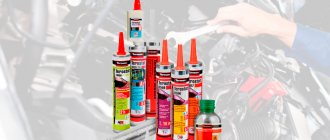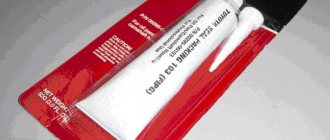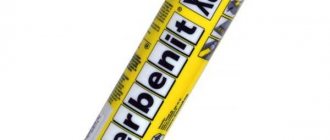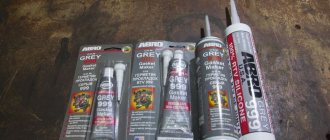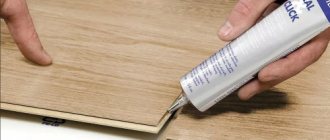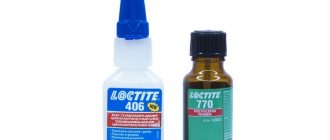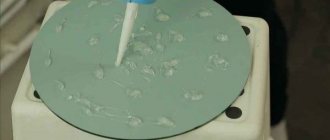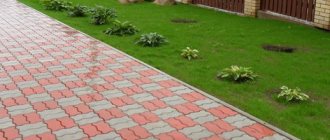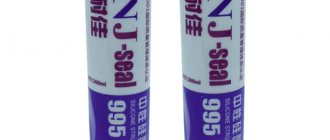Among the many sealants of various types, silicone compounds represent a large share of the modern market. These materials are reliable, easy to use and versatile.
There is a certain classification according to their purpose. A separate category is represented by sealing material, a kind of plumbing glue - silicone sanitary sealant.
Where and for what are these materials used? What are the features of their composition and application? What sanitary sealants can I choose?
In this article we will try to answer these questions and highlight some other points regarding sanitary sealants.
Purpose
One of the advantages of silicone sealants is their excellent moisture resistance. They do not dissolve in water, do not wash out, and create a reliable barrier to moisture penetration. However, you can often notice that in humid, warm rooms, a black coating forms in places where seams are applied and in adjacent areas, which is very difficult to wash off. These are various types of mold and fungal cultures, which not only spoil the aesthetics of the room, but can also cause serious illnesses in humans and pets.
Sanitary silicone sealants, unlike conventional compounds, are intended primarily for use in damp areas to prevent the formation of fungi and mold.
Over time, this sealant does not change its color and ensures impeccable cleanliness in bathrooms, toilets, showers, and basements.
Sanitary white silicone sealants are the most common, but not the only color option. They can also be grey, black, red, clear or other colors. This allows the use of sealants not only for sealing, but also for decorative finishing of premises.
Types of sanitary silicone sealant
The main difference between sanitary silicone sealants is the chemical reactions that occur during the polymerization process. These materials are divided into acidic and neutral.
Acidic
The most common are acid sanitary sealants.
Such sealants are characterized by higher adhesion to many substrates and low cost compared to neutral ones.
However, they also have a number of disadvantages that limit their scope of application.
When this type of sealant cures, acetic acid vapors are released, which have a strong, specific odor. Such sealants are not suitable for marble, calcareous materials, and some non-ferrous metals, since acetic acid reacts with them and causes damage to the surface.
After curing, the vapors evaporate and the odor disappears.
Neutral
Neutral silicone sanitary sealants have no odor. They are non-aggressive towards base materials and are safe for humans.
In terms of adhesion level, these materials are inferior to their acid analogues. In addition, neutral sealants are much more expensive. That is why they are used only when working with materials that are sensitive to acid and where it is important that there is no odor or harmful emissions even during the curing process. It is these sealants that are more preferable when sealing joints with PVC or acrylic. When sealing seams between walls and acrylic bathtubs, it will also be more successful to use neutral compounds.
Colors
Sanitary sealants can also vary in color.
White sanitary caulk is most common. It is used to seal gaps between plumbing fixtures and walls, seal or glue various joints.
Sealing with sanitary silicone transparent sealant is carried out in those places where the composition should not be released in any way. This could be, for example, gluing glass elements or sealing seams between ceramic tiles.
Sealants of other colors are much less common - they are used only for sealing seams when installing colored plumbing fixtures, laying colored wall and floor tiles, baseboards, etc.
Color palette
For the most part, all sanitary sealants are white.
They are used for sealing seams in the bathroom, sealing plumbing fixtures and cracks, and are transparent, which will match any interior color scheme and will remain almost invisible even on bright objects.
However, other colors also appeared on sale: black, gray, brown and beige. Their appearance is due to the demand for such colors.
After all, now you can seal pipes and select a sealant to match the color of the pipes, seal joints or cracks on ceramic tiles with a gel that matches the color.
There are even red sealants - I use them to insulate electrical wiring. Some compositions can be painted after application, after waiting for complete drying.
Characteristics and properties
Like conventional silicone compounds, sanitary sealants are made from the following components:
- Low molecular weight silicone rubbers
- Filler
- Plasticizers to impart elasticity
- Vulcanizers responsible for curing
- Primers to promote adhesion
- Catalysts
- Dyes
However, unlike simple silicone compounds, sanitary sealants contain one more component - fungicidal additives.
The composition of sealants completely determines its performance properties. These compounds have the same characteristics as conventional silicone sealants, but have one advantage - due to fungicides, they actively resist the formation of mold and fungi.
The presence of antifungal and antibacterial additives somewhat limits the scope of application of these materials. Sanitary sealants are not recommended for use in places associated with the vital activity of any organisms (for example, in aquariums and terrariums), and where contact with drinking water or food is possible - for repairing dishes, food containers.
Otherwise, sanitary silicone caulk has the same characteristics and versatility as regular silicone caulk, without the addition of fungicides.
Sanitary sealants have high strength and elasticity, are characterized by chemical inertness, high moisture resistance, are not afraid of both high temperatures and frosts down to -30 ° C, and are not destroyed by ultraviolet light and precipitation.
The drying time of sanitary compounds largely depends on the humidity and temperature of the surrounding air.
At room temperature, the curing rate of the joint is about 2 mm per day. The formation of a surface film occurs, depending on the specific material, within 5-20 minutes. Complete curing occurs within 24 hours, but thick, volumetric joints may require much longer - two days or more. Acid compounds require less time to polymerize - on average, the joint cures within 6-8 hours.
Preparing for sealing
Sealant (Soudal) colorless (1 pack 300 ml - 349 rubles). Photo: Soudal
The bonded surfaces must be thoroughly cleaned of old deposits, dirt, dust and degreased. Moreover, it is advisable to do this on the day of sealing. Before applying silicone sealant, the seams and cavities are not only cleaned, but also dried. It is not advisable to use soapy water or detergents for this, as their residues may impair adhesion. Old sealants and other contaminants are removed from concrete and stone surfaces using a wire brush, and if necessary, special solvent and cleaning compounds are used. Metal, glass and plastic are wiped with an alcohol-containing liquid or solvent, the remains of which are wiped dry with a napkin. To protect areas adjacent to the seam to be sealed from contamination, use adhesive tape. It is removed immediately after completion of work.
Sealant Tytan Professional (Selena) black, colorless (1 pack 310 ml - 380 rub.). Photo: Selena
The surfaces to be treated should not be too cold or hot. The optimal temperature range is 5–40 ˚С. It is advisable to warm the tube with sealant to room temperature. The method of extrusion depends on the type of packaging. The mass appears from the cut tip after squeezing the tube or using a special skeleton-shaped gun placed on the tube. Keep in mind: the average curing speed of the composition indicated on the packaging is valid for average temperature (about 20 ° C) and humidity (50%). Increasing or decreasing these values will speed up or slow down the process. Since the sealant cures with the participation of moisture from the air, it is not recommended to work in poorly ventilated spaces.
How is sanitary sealant applied?
The procedure for working with sanitary sealant is the same as for conventional silicone compounds.
- First of all, the surface must be prepared - cleaned of any remaining old sealant, dirt, dust, mold, cleaned and degreased.
- It is recommended to stick strips of masking tape onto the surfaces adjacent to the seam - it will make the seam more even and neat
- Cut the cartridge spout to the desired size and insert the packaging into the mounting gun
- Squeeze the sealant evenly and apply it in a continuous, even layer to the prepared area.
- Form the seam manually or using special tools. It is necessary to work with gloves to avoid contact of the sealant with the skin of the hands.
- Remove the masking tape. Residues and excess uncured sealant can be removed with a damp cloth or paper. Hardened sealant is removed mechanically (scraper, blade, sharp knife) or using special chemicals (DOWSIL DS-2025, Penta-840, Permaloid, Silicone Remover, Sili-Kill, alcohol, acetone, white spirit)
Recommendations
Before using sanitary sealant, you must carefully study the attached instructions and strictly follow all recommendations given by the manufacturers of these products. Then the purchased sealant will bring comfort and convenience during installation work.
- In order to choose a high-quality sealant, you need to pay attention to the composition. It must contain silicone rubber. This sealant is safe for human health and has no chemical odor at all.
- It is important that the surface being treated remains clean, dry and free of grease, otherwise the sealant may adhere poorly to it or not at all.
- In order for the composition to dry as quickly as possible, it is necessary to improve the ventilation in the room. You can artificially increase the air temperature, this will also shorten the drying time.
Some sanitary sealants harden when exposed to water. It would be good to remove the old one before applying a new seam; this will significantly reduce the drying time.
To purchase quality products, you should pay attention to the expiration date of the product, as well as consult with a specialist and clarify all the characteristics of the product. Having noted all the possible advantages and disadvantages, you need to make the right choice.
Brief overview of popular sanitary sealants
On the shelves of construction stores you can find a lot of sanitary sealants of both foreign and domestic production. The vast majority of them have proven themselves well when using seams in wet areas. As an example, here are some of these materials.
Makroflex SX 101
This acid-type sanitary silicone sealant is developed by Henkel Corporation and is intended for use in wet areas. It has excellent adhesive properties to steel, aluminum, PVC, glass, enamel, ceramics. Resistant to aging, ozone and ultraviolet rays.
When cured, it has a specific vinegar smell, which disappears after polymerization is complete.
Antiseptic components in the sealant prevent the appearance of mold.
Kudo silicone sanitary
This highly elastic sealant creates a durable, elastic seal that will not age or fade. The material is resistant to almost all aggressive environments, water, and detergents. Effectively prevents the formation of fungi and mold.
The sealant has good adhesion to glass, PVC, wood, stainless steel, anodized aluminum, enamel, ceramics, porcelain and other materials.
Chemically neutral, does not damage concrete and non-ferrous metals.
The main area of application is sealing and sealing seams and joints around sinks, bathtubs, swimming pools, sealing plumbing equipment, sealing tile joints, surface waterproofing.
Moment Germent Sanitary
High-quality silicone sanitary sealant for wet areas - toilets, bathrooms, kitchens.
Also used for glazing. Suitable for work both indoors and outdoors. Has good adhesion to ceramics, glass, wood, concrete, enamel and enameled coatings.
Moment Germent Sanitary is resistant to atmospheric and chemical influences and is not destroyed by UV irradiation.
It has an acid curing system and during polymerization it will release a specific odor that disappears after polymerization.
The sealant is available in 85 ml tubes and 280 ml cartridges
Soudal Neutral sanitary silicone
Silicone sealant of Belgian origin. It has a neutral type of curing, so it can be used on concrete and marble surfaces without causing damage.
Characterized by excellent adhesion to porous and smooth substrates - concrete, brick, stone, PVC, glass. Used for glazing and sealing joints between the wall and acrylic, polyacrylic, polycarb baths and trays
Soudal Neutral Sanitary Silicone has a paste consistency and is easy to apply.
Available in white or transparent in 280 ml cartridges.
BISON Sanitary
High-quality durable sanitary silicone sealant for external and internal use.
It is characterized by high elasticity, excellent adhesion to most building materials, and resistance to atmospheric and chemical influences.
It is used for plumbing work, and is also suitable for universal use in glazing, sealing window and door openings, for facade work, for sealing ventilation systems, etc.
Available in 280 ml cartridges, color options - white, transparent.
